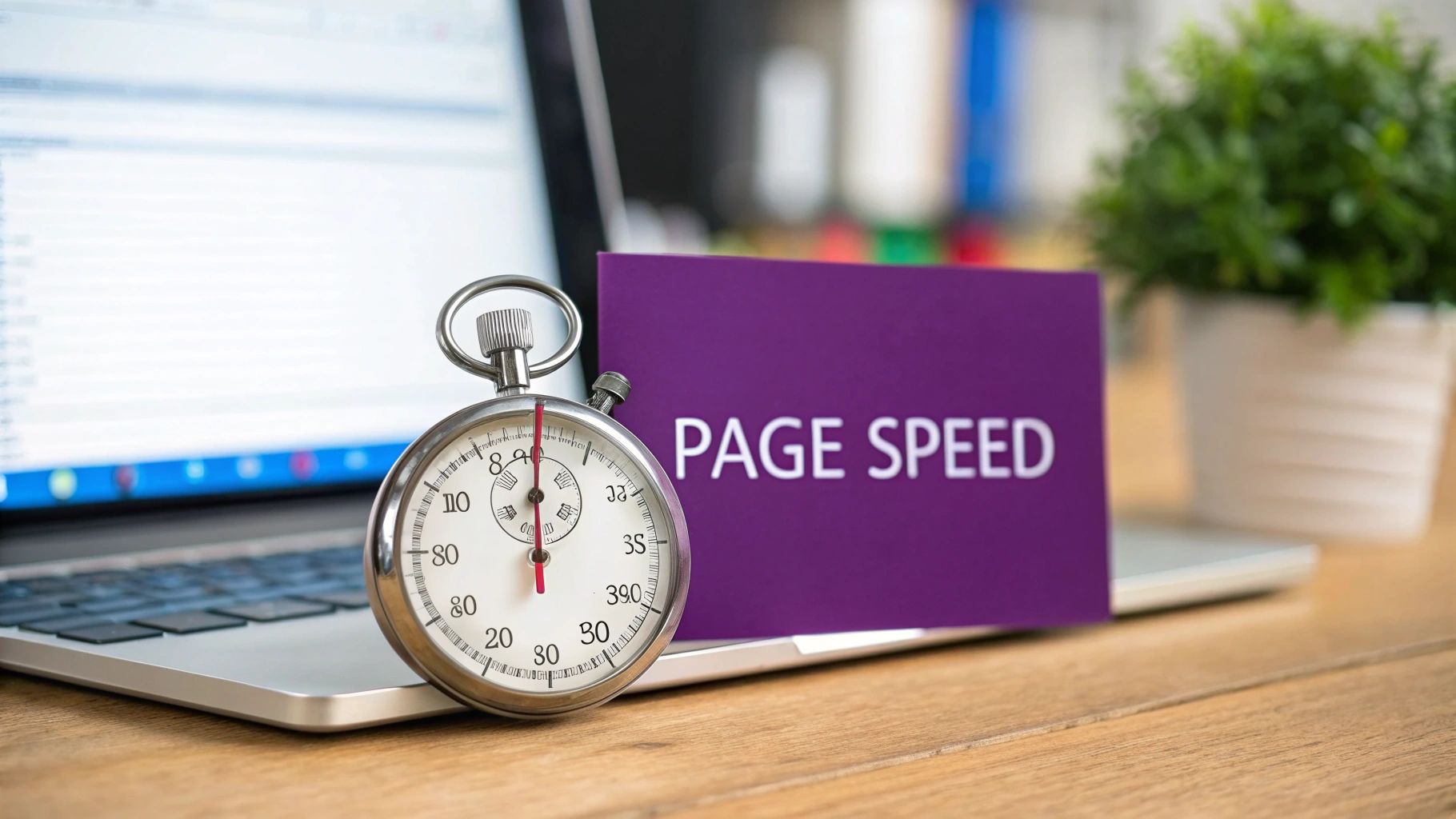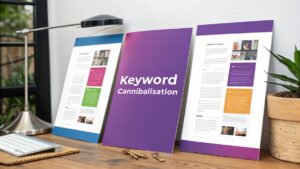In the ever-evolving landscape of digital marketing, mastering search engine optimisation (SEO) is no longer a choice-it's a necessity for businesses aiming to thrive online. While off-page signals like backlinks build external authority, the true foundation of any successful SEO strategy is built upon meticulous on-page optimisation. These are the critical elements you directly control, from your content's structure to its technical implementation. They are the primary signals you send to search engines like Google, telling them precisely what your pages are about and why they deserve to rank prominently. Understanding the core principles of on-page optimization strategies is the first step towards achieving higher rankings and attracting qualified traffic.
This guide provides a comprehensive roundup of the top on-page SEO best practices. We will move beyond generic advice to deliver actionable insights and real-world examples that you can implement immediately. Our goal is to help you refine your website, significantly enhance the user experience, and ultimately, improve your position in the search engine results pages (SERPs). Whether you're a local service provider in Cambridgeshire aiming to attract nearby customers or a growing e-commerce business seeking to increase sales, these practices are fundamental to achieving sustainable digital growth. By focusing on these core components, you create a powerful framework that not only appeals to search engine algorithms but also provides genuine value to your audience, turning visitors into loyal customers.
1. Title Tag Optimisation
The title tag is a powerful HTML element that defines your webpage's title. It appears as the main clickable headline in search engine results pages (SERPs) and is a primary signal to both users and search engines about your page's content. A well-crafted title tag is one of the most critical on-page SEO best practices because it directly impacts click-through rates (CTR) and search rankings, making it a small change with significant potential rewards.
Your title tag is often the first impression a potential visitor has of your page in the search results. It must be compelling enough to entice a click while accurately reflecting the page's content and including your target keywords. This balance is key to both attracting human users and satisfying search engine algorithms.

Why Title Tag Optimisation is Crucial
A strong title tag serves two main purposes: it helps search engines understand and rank your content, and it convinces users to choose your result over competitors'. For SMEs in Cambridgeshire or e-commerce businesses, a precise, benefit-driven title can be the deciding factor for a local customer or online shopper. A poorly optimised title, on the other hand, can lead to low CTR and signal to Google that your page isn't relevant to the search query.
Actionable Tips for Implementation
To get the most out of your title tags, follow these actionable tips:
- Lead with Your Primary Keyword: Place your most important keyword(s) as close to the beginning of the title as possible. This placement gives it more weight with search engines and makes it immediately visible to users scanning the results.
- Keep it Concise: While Google doesn't have a strict character limit, it displays titles based on a 600-pixel container. Aim for 50-60 characters to minimise the risk of your title being truncated in the SERPs.
- Add Your Brand Name: Include your brand name at the end of the title, separated by a pipe (|) or hyphen (-). This builds brand recognition and can increase trust. For example:
On Page SEO Best Practices - Your Brand. - Make it Click-Worthy: Use compelling language, numbers, or questions to spark curiosity. Titles like HubSpot’s benefit-focused "Free Marketing Software | HubSpot" clearly communicate value and encourage clicks.
- Avoid Keyword Stuffing: Repeating keywords unnaturally creates a poor user experience and can be flagged by search engines. Focus on one primary keyword and perhaps a secondary variation if it fits naturally.
2. Meta Description Optimisation
The meta description is an HTML attribute providing a concise summary of your webpage's content. It appears directly below the title tag in search engine results pages (SERPs), acting as a short piece of advertising copy for your page. While Google has confirmed it is not a direct ranking factor, a well-optimised meta description significantly impacts click-through rates (CTR) by persuading users that your page best answers their query.
Think of the meta description as your 155-character sales pitch. It’s your opportunity to stand out in a crowded results page, communicate your unique value proposition, and convince a potential visitor to choose your link over a competitor’s. This makes it an indispensable element of on-page SEO best practices, bridging the gap between visibility and actual traffic.

Why Meta Description Optimisation is Crucial
A compelling meta description convinces searchers your content is what they need, directly influencing user engagement. For an e-commerce business, it can highlight free delivery or a special offer. For a Cambridgeshire service provider, it can include a local benefit or a strong call to action. A neglected or auto-generated description misses a key opportunity to attract qualified traffic, while a well-written one can dramatically improve your CTR, sending positive user engagement signals to search engines.
Actionable Tips for Implementation
To write meta descriptions that drive clicks, follow these actionable tips:
- Keep it to a Compelling Length: Aim for around 150-160 characters. While Google doesn't enforce a strict limit, this length minimises the risk of your message being cut off in the SERPs, especially on mobile devices.
- Include Your Primary Keyword: Placing your main keyword in the description helps reinforce the page's relevance to the searcher. Google often bolds the search query within the description, making your result stand out.
- Write like an Advert: Use an active voice and compelling language. Focus on the benefits for the user. Ask a question or create a sense of urgency to spark curiosity and encourage a click.
- Add a Clear Call-to-Action (CTA): Tell users what you want them to do next. Phrases like "Learn more," "Shop now," or "Get your free quote" are effective. For example, Airbnb’s location-specific descriptions often entice users to ‘Find unique places to stay’.
- Ensure Every Page is Unique: Avoid duplicating meta descriptions across your site. Each description should accurately summarise its specific page's content to avoid confusing users and search engines.
3. Header Tag Structure (H1-H6)
Header tags (H1, H2, H3, etc.) are HTML elements used to create a logical and hierarchical structure for your webpage content. They act as signposts, guiding both users and search engine crawlers through your information, starting from the main topic (H1) and breaking it down into progressively more specific sub-topics (H2-H6). Proper header usage is a fundamental on-page SEO best practice that enhances readability and helps search engines understand the organisation and relevance of your content.
A well-structured page uses headers to create a scannable outline, much like a table of contents in a book. This makes your content far more accessible for users who are skimming for specific information, while also providing crucial context to Google about the relationships between different sections of your text.

Why Header Tag Structure is Crucial
A logical header tag structure is vital for both user experience and search engine optimisation. For users, clear headers break up intimidating blocks of text, making the content easier to scan and digest. For search engines, headers provide a clear topical map of the page, helping them to index the content more effectively and understand its depth. Content marketing blogs like Backlinko and CoSchedule master this by using descriptive H2 and H3 tags, making complex topics easy to navigate.
Actionable Tips for Implementation
To properly organise your content with header tags, follow these actionable tips:
- Use a Single H1 Tag: Your page should have only one H1 tag, which should function as the main title of the page's content. It should contain your primary target keyword and accurately summarise the entire page.
- Maintain a Logical Hierarchy: Structure your headers in a sequential order. Don’t skip levels, for example, by jumping from an H2 directly to an H4. Follow a logical progression: H1 -> H2 -> H3.
- Make Headers Descriptive: Craft headers that clearly describe the content in the section that follows. This helps users find what they are looking for and gives search engines stronger semantic signals.
- Include Keywords Naturally: While your H1 should contain the primary keyword, you can strategically include it and related secondary keywords in your H2s or H3s where it feels natural and adds context.
- Break Up Long-Form Content: Use H2s and H3s to segment lengthy articles into smaller, digestible chunks. This improves readability and keeps users engaged, which can positively impact dwell time and other user-engagement metrics.
4. URL Structure Optimisation
URL structure optimisation is the practice of creating clean, descriptive, and SEO-friendly web addresses that are easy for both users and search engines to understand. A well-structured URL provides crucial context about the page's content, improves user experience, and supports better search engine crawling and indexing. It is a fundamental element of technical and on-page SEO that contributes to your site's overall accessibility and ranking potential.
A logical and readable URL acts as a mini-breadcrumb trail, helping users understand where they are on your website. This clarity can improve trust and navigability, encouraging users to explore further. For search engines, a clean URL helps them grasp the page's topic, making it another valuable signal for determining relevance in the SERPs.

Why URL Structure Optimisation is Crucial
A well-optimised URL is a minor ranking factor, but it significantly enhances user experience, which indirectly influences SEO performance. For an e-commerce business, a URL like yourshop.co.uk/mens-shoes/leather-boots is far more intuitive than yourshop.co.uk/cat.php?id=45&sub=12. Clear URLs are also easier to share and are more likely to be clicked on when pasted into social media or emails, as users can see exactly what the page is about. This clarity is a key component of building a strong on-page SEO foundation.
Actionable Tips for Implementation
To properly organise your URLs, follow these best practices:
- Include Your Primary Keyword: Integrate your main target keyword naturally into the URL slug. For example, a page about on-page SEO best practices should have a URL like
yourdomain.com/blog/on-page-seo-best-practices. - Keep it Short and Simple: Aim to keep URLs concise and descriptive. While there's no firm limit, shorter URLs are generally easier for users to read and remember. Try to stay under 100 characters.
- Use Hyphens to Separate Words: Use hyphens (-) to separate words in your URL path. Search engines interpret hyphens as spaces, making them the standard separator. Avoid underscores (_) or spaces (%20).
- Use Lowercase Letters: Stick to lowercase letters to avoid potential issues with duplicate content, as some web servers treat uppercase and lowercase URLs as separate pages.
- Remove Stop Words: To keep URLs clean and focused, remove unnecessary stop words like "and", "the", "a", or "of". This helps shorten the URL without losing its meaning. For a deeper dive into this topic, you can learn how to optimise URLs for SEO rankings.
5. Internal Linking Strategy
An internal linking strategy involves connecting pages within your own website using hyperlinks. It’s a foundational on-page SEO best practice that organises your site’s architecture, helps search engines discover and understand content relationships, and distributes link equity (or "page authority") throughout your site. A well-executed strategy can significantly boost rankings for your most important pages.
Think of internal links as pathways for both users and search engine crawlers. For users, they provide a clear route to related, valuable information, improving their experience and keeping them on your site longer. For search engines, they create a logical map of your content, signalling which pages are most significant and how different topics are thematically related. This practice was popularised by the very creators of the PageRank algorithm and remains a core component of modern SEO.
Why Internal Linking is Crucial
A robust internal linking structure is vital for establishing topical authority and guiding both users and search engines to your most valuable content. For an e-commerce business, this could mean linking from a blog post about "choosing the right running shoes" directly to relevant product category pages. For a local SME in Cambridgeshire, it might involve linking service pages to case studies or testimonials. Without these connections, important pages can become isolated or "orphaned," making them difficult for Google to find and rank.
Actionable Tips for Implementation
To build an effective internal linking strategy, follow these actionable tips:
- Use Descriptive Anchor Text: Avoid generic phrases like "click here." Instead, use anchor text that is descriptive and includes target keywords, such as "our on-page SEO services." This gives search engines strong context about the linked page.
- Link to Relevant, High-Value Pages: Prioritise linking to and from your most important pages. Connect your blog posts to relevant service or product pages to pass authority and guide users towards conversion.
- Maintain a Natural Link Frequency: A good rule of thumb is to include 2-5 relevant internal links per 1,000 words. The key is to ensure each link adds value for the reader, not to meet a specific quota.
- Create Content Hubs: Organise your content around a central "pillar page" covering a broad topic, and link out to more specific "cluster" articles. This model, used effectively by HubSpot, establishes deep topical authority. For a deeper dive, you can learn more about crafting an Internal Linking Strategy for SEO in 2025.
- Audit Your Links: Use tools like Screaming Frog to regularly audit your internal links. Find and fix broken links (404s) and identify orphaned pages that need to be integrated into your site structure.
6. Image Optimisation
Image optimisation involves a set of techniques used to reduce the file size of your images and make them search-engine friendly without significantly degrading their quality. This encompasses proper file naming, adding descriptive alt text, compressing files, and using responsive image attributes. As a core component of on-page SEO best practices, it directly enhances page load speed, improves user experience, and creates new ranking opportunities in image search results.
Visual content is essential for engaging users, but large, unoptimised images can severely slow down your website, frustrating visitors and harming your rankings. By optimising images, you ensure your pages remain fast and accessible, which is a critical signal for search engines like Google, especially with the focus on Core Web Vitals.
Why Image Optimisation is Crucial
Effective image optimisation serves a dual purpose: it boosts technical SEO performance and improves accessibility. For an e-commerce business, fast-loading, high-quality product images are non-negotiable for driving sales. For local service providers in Cambridgeshire, optimised images can appear in local map packs and image searches, attracting nearby customers. Neglecting this practice leads to slow load times, higher bounce rates, and missed opportunities to rank in visual search, a rapidly growing traffic source.
Actionable Tips for Implementation
To properly optimise your website's images, follow these actionable tips:
- Use Descriptive File Names: Before uploading, rename your image files from generic names like
IMG_0025.jpgto descriptive, keyword-rich names likeon-page-seo-best-practices-checklist.jpg. This provides context to search engines. - Write Meaningful Alt Text: Alternative (alt) text describes an image for screen readers and search engines. Write natural, descriptive alt text under 125 characters that accurately explains the image, incorporating your target keyword where it makes sense.
- Compress Images: Use tools like TinyPNG or ImageOptim to compress your images, reducing their file size. This significantly speeds up page loading. Aim for a balance between file size and visual quality.
- Choose the Right Format: Use JPEG for photographs and images with many colours. Use PNG for images that require a transparent background, like logos. Use WebP for superior compression and quality where supported.
- Implement Responsive Images: Use the
srcsetattribute in your HTML to provide different image sizes for different screen resolutions. This ensures mobile users download a smaller, optimised file, improving their experience.
7. Content Quality and Keyword Optimisation
At the heart of all on-page SEO best practices lies content. Content quality and keyword optimisation is the art of creating valuable, comprehensive, and engaging material that addresses user intent while seamlessly incorporating your target keywords. It moves beyond outdated tactics like keyword stuffing and focuses on building topical authority, achieving semantic relevance, and providing the most complete and helpful answer to a user's query.
For any business, from a local service provider in Cambridgeshire to a global e-commerce brand, high-quality content is the foundation of digital success. It's what earns user trust, encourages social shares, attracts backlinks, and, most importantly, signals to search engines that your page is a premier resource worthy of a high ranking. Think of it as the substance that gives all other technical optimisations purpose.
Why Content Quality and Keyword Optimisation is Crucial
Exceptional content directly addresses Google's core mission: to organise the world's information and make it universally accessible and useful. Pages that demonstrate Expertise, Authoritativeness, and Trustworthiness (E-A-T) are rewarded with better visibility. Poor, thin, or irrelevant content will struggle to rank, no matter how perfectly optimised its title tag or URL might be. It is the cornerstone of a sustainable SEO strategy that delivers long-term results.
Actionable Tips for Implementation
To create and optimise content that genuinely resonates with users and search engines, follow these actionable tips:
- Research User Intent: Before writing, analyse the SERPs for your target keyword. Are the top results "how-to" guides, product pages, or informational articles? Align your content format with what users are clearly looking for.
- Aim for Comprehensive Coverage: Create content that is more thorough and helpful than the existing top-ranking pages. Cover the topic in-depth, answer related questions, and provide unique insights. For instance, an expert guide like those from REI or a detailed financial explanation from Investopedia serves as a definitive resource.
- Use Semantic Keywords: Incorporate Latent Semantic Indexing (LSI) keywords and natural language variations throughout your text. These are conceptually related terms that provide context and help search engines understand the topic more deeply.
- Leverage Optimisation Tools: Use platforms like Surfer SEO or Clearscope to analyse top-ranking content and receive data-driven suggestions for keywords, structure, and word count to include in your piece. As you refine your content and keyword strategy for on-page SEO, exploring resources on the best generative search optimization tools can provide valuable insights into leveraging AI for enhanced visibility.
- Keep Content Fresh: Regularly update and refresh your content with new information, statistics, and examples. This signals to Google that your content is still relevant and accurate, which can help maintain or improve its rankings.
8. Page Loading Speed Optimisation
Page loading speed optimisation involves a combination of technical and content-based improvements to reduce the time it takes for a webpage to load fully. It is a fundamental on-page SEO best practice because it directly influences user experience and search engine rankings. With Google's Core Web Vitals now established as significant ranking factors, a fast, responsive website is no longer a luxury but a necessity for digital success.
In today's fast-paced digital environment, users expect instant access to information. A slow-loading page leads to high bounce rates, as visitors will quickly leave for a competitor's faster site. For search engines like Google, page speed is a clear indicator of quality; a fast site provides a better user experience, which Google aims to reward with higher rankings.
Why Page Loading Speed Optimisation is Crucial
A slow website can be detrimental to your business goals. It frustrates users, diminishes brand perception, and directly harms your search engine visibility. For an e-commerce business, even a one-second delay in page load time can lead to a significant drop in conversions. For SMEs in Cambridgeshire, a speedy site can be the competitive edge that keeps a local customer engaged long enough to make an enquiry. Optimising your speed is therefore a critical investment in both user satisfaction and SEO performance.
Actionable Tips for Implementation
To improve your site’s performance, follow these actionable tips:
- Audit Your Performance: Use tools like Google PageSpeed Insights to get a detailed report on your site's speed and Core Web Vitals. This will provide a clear baseline and a list of specific areas for improvement.
- Implement Lazy Loading: Configure images, videos, and iframes to load only when they are about to enter the user's viewport. This technique significantly reduces initial page load time and conserves bandwidth.
- Optimise Your Images: Compress images to reduce their file size without sacrificing too much quality. Using modern image formats like WebP where possible can offer superior compression compared to traditional JPEGs and PNGs.
- Choose Fast, Reliable Hosting: Your hosting provider is the foundation of your site's speed. A cheap, shared hosting plan can severely limit your performance. Invest in a quality hosting solution that meets your traffic and performance needs. For an in-depth guide on enhancing your site's performance, explore expert tips on how to improve website loading speed.
9. Mobile-First Optimisation
Mobile-first optimisation is a design and development strategy that prioritises the mobile experience. Instead of designing for a large desktop screen and then scaling down, you start with the mobile version and progressively enhance it for larger screens. With Google’s mobile-first indexing now standard, the mobile version of your site is the primary one used for ranking and indexing, making this one of the most essential on-page SEO best practices for modern digital success.
The shift to mobile-first isn't just about appeasing Google; it's about meeting user expectations. The majority of web traffic now originates from mobile devices, so a seamless, fast, and intuitive mobile experience is crucial for engaging and converting visitors. For a local SME in Cambridgeshire, a customer searching for services on their phone needs a site that works flawlessly, or they will quickly go to a competitor.
Why Mobile-First Optimisation is Crucial
A strong mobile-first approach directly impacts your search engine rankings and user experience. Google prioritises sites that offer a great experience to its mobile users, meaning a poor mobile site can severely harm your visibility. It ensures faster loading times, easier navigation, and better accessibility on smaller screens, which collectively reduce bounce rates and increase engagement signals that Google values. In essence, your mobile site is your primary site in the eyes of search engines.
Actionable Tips for Implementation
To properly implement a mobile-first strategy, consider these actionable tips:
- Implement Responsive Design: Use a responsive web design framework that fluidly adapts your content to any screen size. Modern CSS techniques like Flexbox and Grid make creating flexible, mobile-friendly layouts more manageable than ever.
- Prioritise Performance: Mobile users expect speed. Compress images, minify CSS and JavaScript, and leverage browser caching to ensure your site loads quickly on mobile networks. Use Google's PageSpeed Insights to test and identify issues.
- Optimise for Touch: Ensure all interactive elements, like buttons and links, are large enough to be easily tapped. A minimum size of 44×44 pixels is a recommended guideline to avoid user frustration.
- Simplify Navigation and Forms: Design a simple, intuitive navigation menu for small screens. Ensure that any forms are easy to complete on a mobile device, with large input fields and appropriate keyboard types (e.g., a number pad for phone number fields).
- Test Rigorously: Use Google’s Mobile-Friendly Test tool to get an instant analysis of your page. Beyond tools, test your site manually on various physical devices (both iOS and Android) to catch real-world usability issues.
10. Schema Markup Implementation
Schema markup, or structured data, is a powerful semantic vocabulary you add to your website's HTML. It translates your content into a language that search engines can easily understand, moving beyond just crawling keywords to comprehending context. By implementing schema, you help search engines create enhanced, informative search results known as rich snippets, which is a core part of modern on-page SEO best practices.
These rich snippets, such as star ratings, event dates, or recipe cooking times, make your listing stand out on the SERP. For an e-commerce business, showing a product's price and review rating directly in the search results can dramatically improve click-through rates. Schema provides the explicit clues Google needs to display your content more attractively and accurately.
Why Schema Markup Implementation is Crucial
Implementing schema is crucial because it directly influences how your website is presented in search results, giving you a competitive edge. Rich snippets don't just look better; they provide immediate answers and value to users, which can significantly increase CTR and drive more qualified traffic. For a local SME in Cambridgeshire, using LocalBusiness schema can display opening hours and contact details, making it easier for nearby customers to engage. Failing to use it means missing a key opportunity to enrich your search presence.
Actionable Tips for Implementation
To effectively implement schema markup, follow these actionable tips:
- Use JSON-LD: Implement schema using the JSON-LD (JavaScript Object Notation for Linked Data) format. It is Google’s recommended method as it's easier to implement and manage without altering existing HTML code.
- Start with Key Schema Types: Prioritise the most impactful schema types for your business. Common and effective types include Article for blog posts, Product for e-commerce items, LocalBusiness for physical locations, and Review for customer ratings.
- Validate Your Code: Always use Google’s Rich Results Test tool to validate your schema markup before and after deployment. This ensures it's free of errors and eligible for rich snippet display.
- Monitor Performance: After implementation, use Google Search Console to track the performance of your rich results. The "Enhancements" report will show clicks and impressions for pages with valid structured data, helping you measure its impact. Learning about the different types and their benefits is a great first step; you can explore more about why schema markup is important for SEO to deepen your understanding.
On-Page SEO Best Practices Comparison
| SEO Technique | Implementation Complexity | Resource Requirements | Expected Outcomes | Ideal Use Cases | Key Advantages |
|---|---|---|---|---|---|
| Title Tag Optimisation | Low | Minimal (basic HTML editing) | Improved rankings and higher CTR | Any webpage aiming for better SERP CTR | Direct ranking impact; easy to implement |
| Meta Description Optimisation | Low to Medium | Minimal content writing | Increased CTR and better user engagement | Pages targeting increased clicks | Controls snippet text; boosts CTR |
| Header Tag Structure (H1-H6) | Low to Medium | Basic HTML knowledge | Better content structure and readability | Content-rich pages, blogs | Enhances readability and SEO clarity |
| URL Structure Optimisation | Medium | Web architecture planning | Better user experience and keyword relevance | New sites or restructuring older URLs | Improves usability and link sharing |
| Internal Linking Strategy | Medium to High | Ongoing content and site audits | Enhanced page authority and user navigation | Larger sites with extensive content | Distributes link equity; improves site navigation |
| Image Optimisation | Medium to High | Design and technical expertise | Faster load times, accessibility, image traffic | Media-heavy and e-commerce sites | Improves speed, accessibility, and image SEO |
| Content Quality & Keyword Optimisation | High | Significant content creation time | Long-term rankings and user engagement | Authority sites and competitive niches | Builds topical authority and natural backlinks |
| Page Loading Speed Optimisation | Medium to High | Technical resources and monitoring | Better rankings and user retention | All sites, especially e-commerce and news | Direct ranking benefit; improved UX |
| Mobile-First Optimisation | Medium to High | Design and development effort | Better mobile rankings and improved UX | Mobile-focused sites or broad audiences | Aligns with Google’s indexing; captures mobile users |
| Schema Markup Implementation | High | Technical expertise required | Enhanced SERP features and higher CTR | E-commerce, local businesses, news sites | Rich snippets; voice search benefits |
Bringing It All Together: From Best Practices to Tangible Results
Navigating the landscape of digital marketing can feel complex, but mastering the elements within your control is the most powerful first step. The ten on page SEO best practices detailed in this guide are not merely items on a checklist; they represent the foundational pillars upon which sustainable search visibility is built. From the precision of a well-crafted title tag to the technical nuance of schema markup, each component sends a clear signal to search engines like Google about your content's relevance, authority, and quality.
Think of your website as an intricate machine. The content is its engine, but on-page optimisation is the fine-tuning that ensures it runs efficiently, powerfully, and smoothly. Without proper header structures, internal links, and image optimisation, even the most brilliant content can fail to perform. Conversely, a website that is technically sound but lacks substantive, user-focused content is like a pristine engine with no fuel. True success lies in the synergy between these elements, where each practice amplifies the impact of the others.
Key Takeaways for Immediate Action
To move from theory to tangible results, focus on these core principles:
- User-Centricity is Paramount: Every optimisation, from page speed to mobile-friendliness, ultimately serves the user. A positive user experience is directly correlated with better search rankings. Ask yourself: "Does this change make my website more helpful, accessible, and engaging for my target audience?"
- Consistency Breeds Authority: A haphazard approach yields haphazard results. Systematically apply these best practices across all relevant pages. A consistent URL structure, a logical internal linking strategy, and uniform image optimisation create a cohesive site architecture that search engines favour.
- On-Page SEO is a Continuous Process: The digital environment is never static. Search engine algorithms evolve, competitor strategies shift, and user expectations change. Regularly auditing your pages, refreshing old content, and testing new approaches are not optional tasks but essential maintenance for your digital asset. Adopting this mindset transforms SEO from a one-off project into a core business activity that drives continuous improvement and growth.
Your Next Steps: From Knowledge to Implementation
The journey to mastering on page SEO best practices begins with a single, decisive step. Don't let the scope of this list overwhelm you. Instead, use it as a strategic roadmap. Start by conducting a simple audit of your most important pages, perhaps your top-performing blog post or a key service page.
Identify the low-hanging fruit. Is your H1 tag missing or duplicated? Are there images with unhelpful file names like IMG_8765.jpg? Are crucial pages lacking internal links? Addressing these smaller, actionable items first can build momentum and deliver noticeable improvements quickly. For businesses in Cambridgeshire and beyond, from local service providers to growing e-commerce stores, applying these principles methodically can be a game-changer, directly impacting lead generation and sales. Embracing these techniques empowers you to take direct control of your website's performance, turning it from a passive online brochure into a dynamic, lead-generating powerhouse.
Ready to turn these best practices into a powerful growth strategy for your business? At Bare Digital, we specialise in creating bespoke SEO campaigns built on these foundational principles. We help SMEs and e-commerce businesses transform their online presence with data-driven, transparent, and results-focused SEO services. Visit Bare Digital to request a complimentary SEO Health Check and receive a clear, actionable proposal within 24 hours.








